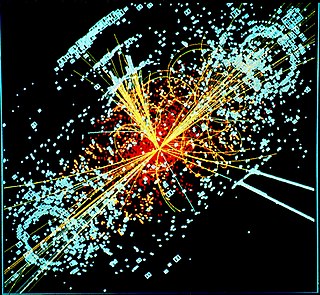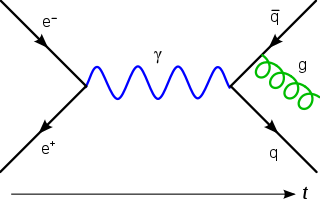String field theory (SFT) is a formalism in string theory in which the dynamics of relativistic strings is reformulated in the language of quantum field theory. This is accomplished at the level of perturbation theory by finding a collection of vertices for joining and splitting strings, as well as string propagators, that give a Feynman diagram-like expansion for string scattering amplitudes. In most string field theories, this expansion is encoded by a classical action found by second-quantizing the free string and adding interaction terms. As is usually the case in second quantization, a classical field configuration of the second-quantized theory is given by a wave function in the original theory. In the case of string field theory, this implies that a classical configuration, usually called the string field, is given by an element of the free string Fock space.
In theoretical physics, twistor theory was proposed by Roger Penrose in 1967 as a possible path to quantum gravity and has evolved into a widely studied branch of theoretical and mathematical physics. Penrose's idea was that twistor space should be the basic arena for physics from which space-time itself should emerge. It has led to powerful mathematical tools that have applications to differential and integral geometry, nonlinear differential equations and representation theory, and in physics to general relativity, quantum field theory, and the theory of scattering amplitudes.

In theoretical physics, supergravity is a modern field theory that combines the principles of supersymmetry and general relativity; this is in contrast to non-gravitational supersymmetric theories such as the Minimal Supersymmetric Standard Model. Supergravity is the gauge theory of local supersymmetry. Since the supersymmetry (SUSY) generators form together with the Poincaré algebra a superalgebra, called the super-Poincaré algebra, supersymmetry as a gauge theory makes gravity arise in a natural way.
In physics, the S-matrix or scattering matrix is a matrix which relates the initial state and the final state of a physical system undergoing a scattering process. It is used in quantum mechanics, scattering theory and quantum field theory (QFT).
Bosonic string theory is the original version of string theory, developed in the late 1960s and named after Satyendra Nath Bose. It is so called because it contains only bosons in the spectrum.
In quantum physics, Regge theory is the study of the analytic properties of scattering as a function of angular momentum, where the angular momentum is not restricted to be an integer multiple of ħ but is allowed to take any complex value. The nonrelativistic theory was developed by Tullio Regge in 1959.

In quantum field theory, a branch of theoretical physics, crossing is the property of scattering amplitudes that allows antiparticles to be interpreted as particles going backwards in time.
In theoretical physics, the superconformal algebra is a graded Lie algebra or superalgebra that combines the conformal algebra and supersymmetry. In two dimensions, the superconformal algebra is infinite-dimensional. In higher dimensions, superconformal algebras are finite-dimensional and generate the superconformal group.

Gabriele Veneziano is an Italian theoretical physicist widely considered the father of string theory. He has conducted most of his scientific activities at CERN in Geneva, Switzerland, and held the Chair of Elementary Particles, Gravitation and Cosmology at the Collège de France in Paris from 2004 to 2013, until the age of retirement there.
String cosmology is a relatively new field that tries to apply equations of string theory to solve the questions of early cosmology. A related area of study is brane cosmology.
In theoretical physics, a dual resonance model arose during the early investigation (1968–1973) of string theory as an S-matrix theory of the strong interaction.
In theoretical physics, the Haag–Łopuszański–Sohnius theorem states that if both commutating and anticommutating generators are considered, then the only way to nontrivially mix spacetime and internal symmetries is through supersymmetry. The anticommutating generators must be spin-1/2 spinors which can additionally admit their own internal symmetry known as R-symmetry. The theorem is a generalization of the Coleman–Mandula theorem to Lie superalgebras. It was proved in 1975 by Rudolf Haag, Jan Łopuszański, and Martin Sohnius as a response to the development of the first supersymmetric field theories by Julius Wess and Bruno Zumino in 1974.
The history of string theory spans several decades of intense research including two superstring revolutions. Through the combined efforts of many researchers, string theory has developed into a broad and varied subject with connections to quantum gravity, particle and condensed matter physics, cosmology, and pure mathematics.
Miguel Ángel Virasoro was an Argentine mathematician and theoretical physicist. Virasoro worked in Argentina, Israel, the United States, and France, but he spent most of his professional career in Italy at La Sapienza University of Rome. He shared a name with his father, the philosopher Miguel Ángel Virasoro. He was known for his foundational work in string theory, the study of spin glasses, and his research in other areas of mathematical and statistical physics. The Virasoro–Shapiro amplitude, the Virasoro algebra, the super Virasoro algebra, the Virasoro vertex operator algebra, the Virasoro group, the Virasoro conjecture, the Virasoro conformal block, and the Virasoro minimal model are all named after him.
In physics, Liouville field theory is a two-dimensional conformal field theory whose classical equation of motion is a generalization of Liouville's equation.
This page is a glossary of terms in string theory, including related areas such as supergravity, supersymmetry, and high energy physics.
Vasiliev equations are formally consistent gauge invariant nonlinear equations whose linearization over a specific vacuum solution describes free massless higher-spin fields on anti-de Sitter space. The Vasiliev equations are classical equations and no Lagrangian is known that starts from canonical two-derivative Frønsdal Lagrangian and is completed by interactions terms. There is a number of variations of Vasiliev equations that work in three, four and arbitrary number of space-time dimensions. Vasiliev's equations admit supersymmetric extensions with any number of super-symmetries and allow for Yang–Mills gaugings. Vasiliev's equations are background independent, the simplest exact solution being anti-de Sitter space. It is important to note that locality is not properly implemented and the equations give a solution of certain formal deformation procedure, which is difficult to map to field theory language. The higher-spin AdS/CFT correspondence is reviewed in Higher-spin theory article.
In string theory, the Ramond–Neveu–Schwarz (RNS) formalism is an approach to formulating superstrings in which the worldsheet has explicit superconformal invariance but spacetime supersymmetry is hidden, in contrast to the Green–Schwarz formalism where the latter is explicit. It was originally developed by Pierre Ramond, André Neveu and John Schwarz in the RNS model in 1971, which gives rise to type II string theories and can also give type I string theory. Heterotic string theories can also be acquired through this formalism by using a different worldsheet action. There are various ways to quantize the string within this framework including light-cone quantization, old canonical quantization, and BRST quantization. A consistent string theory is only acquired if the spectrum of states is restricted through a procedure known as a GSO projection, with this projection being automatically present in the Green–Schwarz formalism.
Massless free scalar bosons are a family of two-dimensional conformal field theories, whose symmetry is described by an abelian affine Lie algebra.
The Gross conjecture regarding high energy symmetry of string theory was based on the saddle-point calculation of hard string scattering amplitudes (SSA) of both the closed and open string theories. The conjecture claimed that there existed infinite linear relations among hard SSA of different string states. Moreover, these infinite linear relations were so powerful that they can be used to solve all the hard SSA and express them in terms of one amplitude. Some monographs had made speculations about this hidden stringy symmetry without getting any conclusive results. However, the saddle-point calculation of the hard SSA which was claimed to be valid for all string states and all string loop orders was pointed out to be inconsistent for the cases of the excited string states in a series of works done by the method of decoupling of zero-norm states (ZNS).








